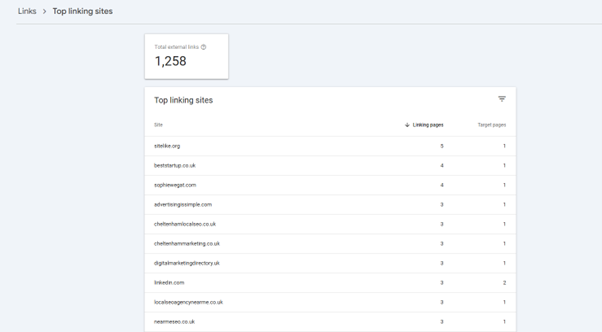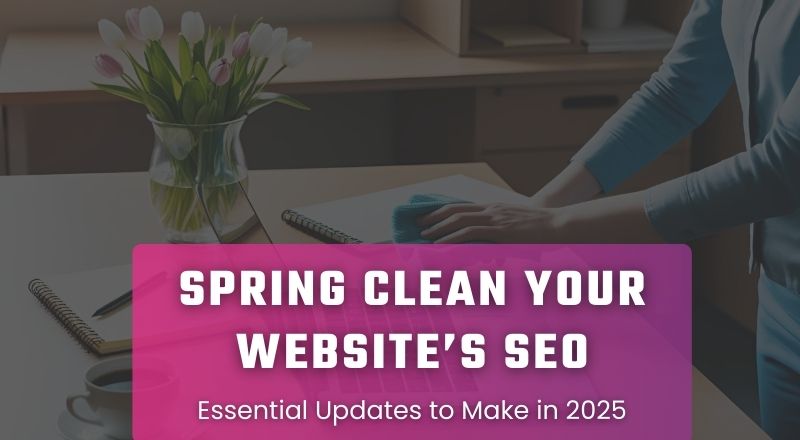Spring is officially here (whether it feels like it all of the time is another question) the bulbs are starting to bloom; the days are getting longer and brighter and your website… well, it’s looking a little dusty.
Just like that junk drawer, or garage full of years of stuff you no longer need, your website’s SEO could use a good refresh – especially if you are not actively reviewing it regularly.
Let’s dive in and find out how to give your SEO a deep clean and make sure your site is fresh, fast and ranking higher in 2025.
Step 1: Sweep Away Old, Outdated Content
When was the last time you reviewed your website page content or old blog posts?
Google loves up to date and fresh content and your audience will love content that is relevant, so if you haven’t reviewed your pages for a while then you might find that they feature out of date information or even no longer reflect who you are as a business.
If you have been actively blogging for several years, by now you have built up a good library of posts however, is that blog post from 2018 about “The Future of <insert your industry>” still relevant?
Have a review of your old blog posts you may find that some are still useful, but they just need to be brought up to date for 2025 (a really easy way to add fresh content to your site) or if something isn’t useful or driving traffic then remove it all together.
Actionable Tips for Cleaning up Old SEO’d Content
- Identify underperforming pages – look at your Google Search Console and Analytics to identified pages which aren’t performing in terms of time on page and take steps to improve the content.
- Update outdated blog posts – think about adding fresh data, new insights and improve the formatting.
- Remove or redirect dead pages – if your pages or blogs are no longer relevant or useful then remove them and apply a 301 redirect or a 410 page gone.
Step 2: Dust Off your Keyword Strategy
Whether you have a targeted keyword strategy for key pages on your site, or you write content hoping you might rank for a phrase, you still need to keep reviewing what your pages are optimised for.
Keyword trends vary over time and search phrases that were once easier to rank for can become much more competitive, once other websites owners identify that they should also targeted those phrases.
You may have always once ranked for a blog post which targeted “best social media platforms for 2020” which is no longer going to be relevant, hence why you no longer rank and notice a dip in traffic.
Actionable Tips for Refreshing your Keyword Strategy
- You can use tools like Google Trends and SEMRush to conduct keyword research to better understand new keyword trends and the latest competition.
- Sometimes long-tail or conversational search queries are much easier to rank for so try targeting them in your blog content.
- Google is smart and if you try ramming your target keyword as much as possible into your content that isn’t going to work. Optimise your page for search intent by understanding what your users are looking for an create content which addresses those needs.
- Consider your sub headings – do they naturally use your keyword terms? Implementing them naturally into relevant subheadings can help your audience make better sense of your content, all good for SEO too!
Step 3: Polish Up your Technical SEO
Optimising your website for search engines isn’t just about writing your content for the right keywords you need to also be thinking about these technical SEO factors:
Site speed: if your website isn’t loading in more than a couple of seconds then you have a problem. Users want quick solutions so if your website isn’t fast then it is likely to put people off.
Mobile responsivity: your website should be responsive, look great and easy to use across all devices, especially on mobile. If there are barriers to navigating around your site, completing an action, or your site just doesn’t look great on mobile you are likely to be losing valuable leads.
Broken links: have you ever loaded a page and got a 404 error? Broken links and pages are not only annoying for users, but too many of them can tell Google you have a problem with your site and this can have a negative impact on rankings.
User experience: Google doesn’t just care about keywords; it loves websites that are designed with users in mind, because these sites better focus on helping a user achieve their goals providing more value, therefore this can help to rank higher. Check out other recent blog for more tips on improving the user experience of your website.
Actionable Tips for Improving your Technical SEO
- Use tools like PageSpeed Insights or GTMetrix to check the speed of your website pages and identify improvements. You won’t believe how much of an impact large images can have on load speed.
- If you are too close to your website, why not have a peer or friend review the user experience on a mobile device to make sure it is optimised and give you feedback on what they found more difficult. Alternatively you can invest in user testing.
- If you have changed page urls or removed pages recently then make sure you add redirects to avoid having broken links.

Step 4: Freshen Up your Content Strategy
Google loves fresh content almost as much as people love the smell of freshly cut grass. You may think that you have created this wonderful looking website, optimised your content for Google and are starting to rank for some search phrases and that is enough.
Well let us tell you, it’s not!
Google loves a website that is kept up to date with fresh content (when relevant to do so). Data, information, trends and even people change, therefore the information on your website needs to be kept up to date so that it is constantly helping users with the most relevant information for them.
Actionable Tips for Keeping your Website Content Fresh
- If you don’t already, add a blog to your website. This is an easy way to add fresh content (amongst other advantages) that adds value to site visitors.
- Review and update your title tags and meta descriptions to optimise them for better click through rates.
- Users don’t just want to know what products or services you can provide. Enhance your content with testimonials or case studies from real customers or add FAQs to answer real questions.
Step 5: Declutter your Backlink Profile
Once upon a time it was believed that the more backlinks you have to your site the more you are likely to rank because these links suggest that your website is worth visiting.
Well Google is a lot smarter than that and having thousands of poor quality links is going to do more harm to your rankings than good.
Yes, building links to your site is a good thing, but this should be done from quality, relevant sources and over an extended period of time.
Actionable Tips for Cleaning Up Those Unwanted Backlinks
- You can use tools like Ahrefs and Google Search Console to audit what links you have going to your website.
- If you find any links which look spammy or toxic then note them down. But don’t disavow them UNLESS you get a Manual Penalty from Google – this will be indicated in your Google Search Console account. You can find instructions on how to disavow links here, but don’t hesitate to reach out to us if you need some help.
- Think about how you can earn quality backlinks from guest blogging, creating digital PR, adding listings on relevant industry directories and creating partnerships with other businesses too.

Bonus: Add a Touch of AI
We don’t want to suggest that you can leave your SEO in the hands of AI, because at the moment AI isn’t sophisticated enough to replicate human authorship. Google is smart enough to understand what content has been written by a person or a machine, though they have said they won’t punish AI generated content we think they may will do so in the future.
But you can’t pretend that AI doesn’t exist, and it can have some benefits in terms of streamlining your processes and helping you with ideas.
4 Ways AI can Help with SEO on your Website
- You can use AI to help generate content ideas for your website SEO. This may be coming up with topics that people are searching for or even suggesting a plan for your page for blog post.
- Leverage AI for content optimisation. Why not ask AI to review your existing web page content and ask it for suggestions on how to improve it.
- Have AI help you come up with link ideas for your site, sometimes it can be quite creative!
- Instead of having AI write the whole article, instead ask it for a list of sub headings to give you based on your content idea and keywords, then you do the rest from the list it provides.
If you do decide to ask AI to write your content in full, we do recommend you review it and edit it yourself (tweaks aren’t enough!) to make sure it is in line with your brand voice and not just robotic nonsense.
ATW – Otherwise Known as your SEO Deep Cleaners
SEO is a long-term and ongoing strategy. You can’t just set it and forget it, otherwise it can gather up dust and overtime sink down the search engine rankings. A little spring clean now can mean better rankings, more traffic and a more effective website all year round.
If you need support with spring cleaning your website’s SEO, then let’s get started now.
Email: hello@allthingsweb.co.uk
Call: 01285 50 55 50

